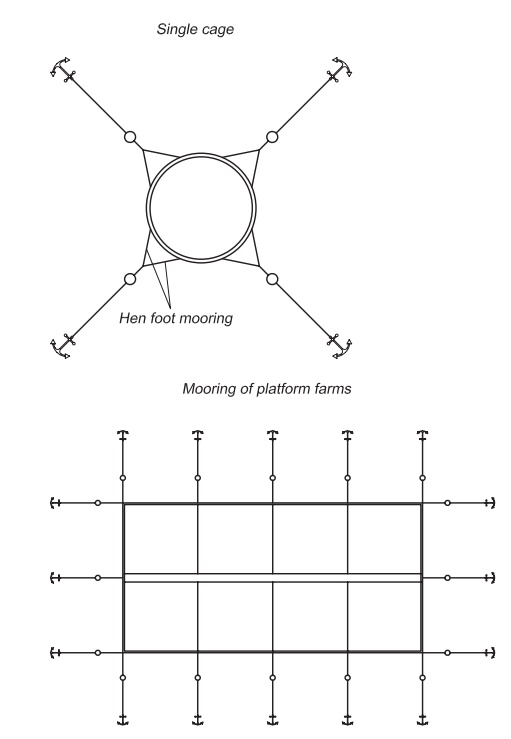Chapter: Aquaculture Engineering : Sea Cages
Design of the mooring system
Design of the mooring system
The design used
for the mooring system depends on the type of cages to be moored: these may be
as follows (Fig. 15.16):
· Single cages
· System for
mooring several single cages
· Single cages
with walkway
· Single cages
with walkway and landing
· Group of cages – platform cages
· Ocean cages
· Cages lying on sway.


A single cage
may be moored by between four and six single buoys attached to anchors and to
the cage by mooring lines. It is recommended that the single mooring line be
divided into two before the fixing point to the cage; this is known as the hen
foot mooring; it reduces the forces at the points of attachment to the cage
framework, because the number of fixing points is doubled. The points of
attachment are critical in the mooring system, because all forces are
transferred through these points. The cost of mooring single cages is high; the
system is most viable for circular and polygonal cages.
Today, systems
for mooring several cages are more usually used. Two or three longitudinal
mooring lines are attached to each other with trans-verse mooring lines; in
this way a frame where the single cages can be fixed is built. By lowering the
frame 1–2 m below the water surface, access to the cages by boat is improved.
Here again, the single cages are attached to the frame with a hen foot mooring.
One single cage may be removed, taken out from the system and transferred to
another site.
Single cages
may also be moored to walkways. If the walkway has a landing, the requirement
to keep the cages in the same position is greater (high position exactness);
the pre-stress in the mooring lines must also be higher. With such moorings the
problem is that the wave is transmitted through the cage and the walkway with
different velocities, resulting in large forces at the connection points. The
connection point may therefore be subject to material failure. To reduce the
forces it is advanta-geous to use several connection points. Alterna-tively,
the connection point must be flexible. Fixed connections to walkways are not
recommended in exposed water.
In ocean cages
the requirements for the moorings system are large because the forces are so
great. Ocean cages are moored individually and the producer will normally have
their own mooring systems, which could be an integral part of the cage
construction.
In a platform
cage farm the mooring line is typically withdrawn from each corner and from the
middle of the farm. Such farms are normally sited in protected water because
they tolerate lower waves, due to their construction with linkages.
If the sway
principle is used, only one mooring point is necessary; it is actually a slack
mooring. This mooring point is exposed to large forces and a big anchor and
buoy are necessary. Such farms need a large area because the unit will drift
around the mooring point. Ageing of the sites is, however, delayed when using
this arrangement. However, the method is seldom used, mainly because such a
large area is necessary.
Related Topics